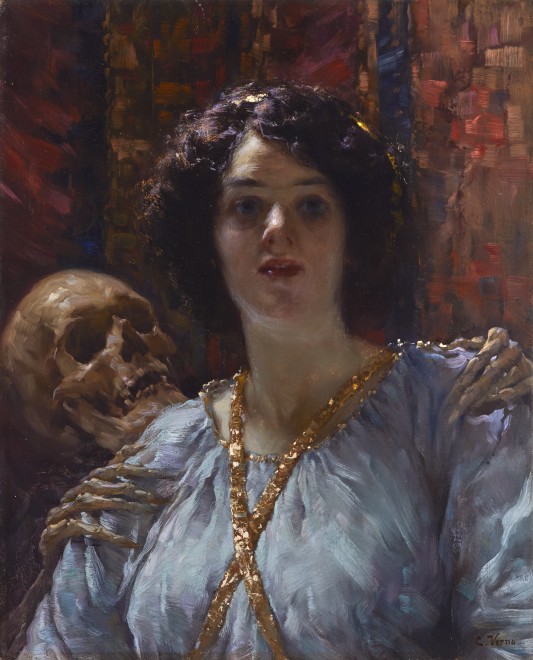Provenance
Private collection, Germany;
with Galerie Konrad Bayer, Munich
Exhibitions
La Societa ‘Promotrici di Belle Arti, Genoa 1915, there titled “Ruit hora”.
Galerie Konrad Bayer, Munich 2014: “Images of Love and Death”, listed and illustrated in the exhibition catalogue #3, and as cover illustration of the publication.
With Death and the Maiden Camillo Verno presents the viewer with a classic vanitasor momento mori portrait. Painted circa 1895, the young woman, quite possibly the artist’s wife and model, is embraced from behind by a leering skeleton, clearly symbolic of the shortness and fragility of human life and the inevitability of death.
Death and the Maiden was a common motif in Renaissance art and finds its roots in the Danse Macabre, an artistic genre of allegory of the Late Middle Ages on the universality of death (fig. 1). No matter one’s station in life, the Danse Macabre unites us all. The German artist Hans Baldung famously depicted the subject of Death and the Maiden several times in his career (fig. 2).The theme was revived in the arts during the Romantic era, and variants of the subject occur in well-known self- portraits by such contemporary artists of Verno as Hans Thoma (fig. 3) and Arnold Böcklin (fig. 4).
Camillo Verno was born near the Swiss border in the northern Italian village of Rusa di Campertogno. He studied at the Albertina Academy in Turin and made his artistic debut in the Societa Promotrice delle Belle Arti of 1891. Verno then competed at the Exposizioni Nazionali in Turin, Milan, Florence, and Rome as well as at the Internationali held in Munich, London, and Barcelona. He obtained many distinc- tions and won bronze, silver, and gold medals.
Verno was a member of the Accademia Albertina, professor at the Neopolitan Institute of Fine Arts, a teacher at the Modena Academy, and Director of the Adolfo Venturi Institute of Art in Modena. Verro died in his birth town of Rusa die Campertogno in 1942.
